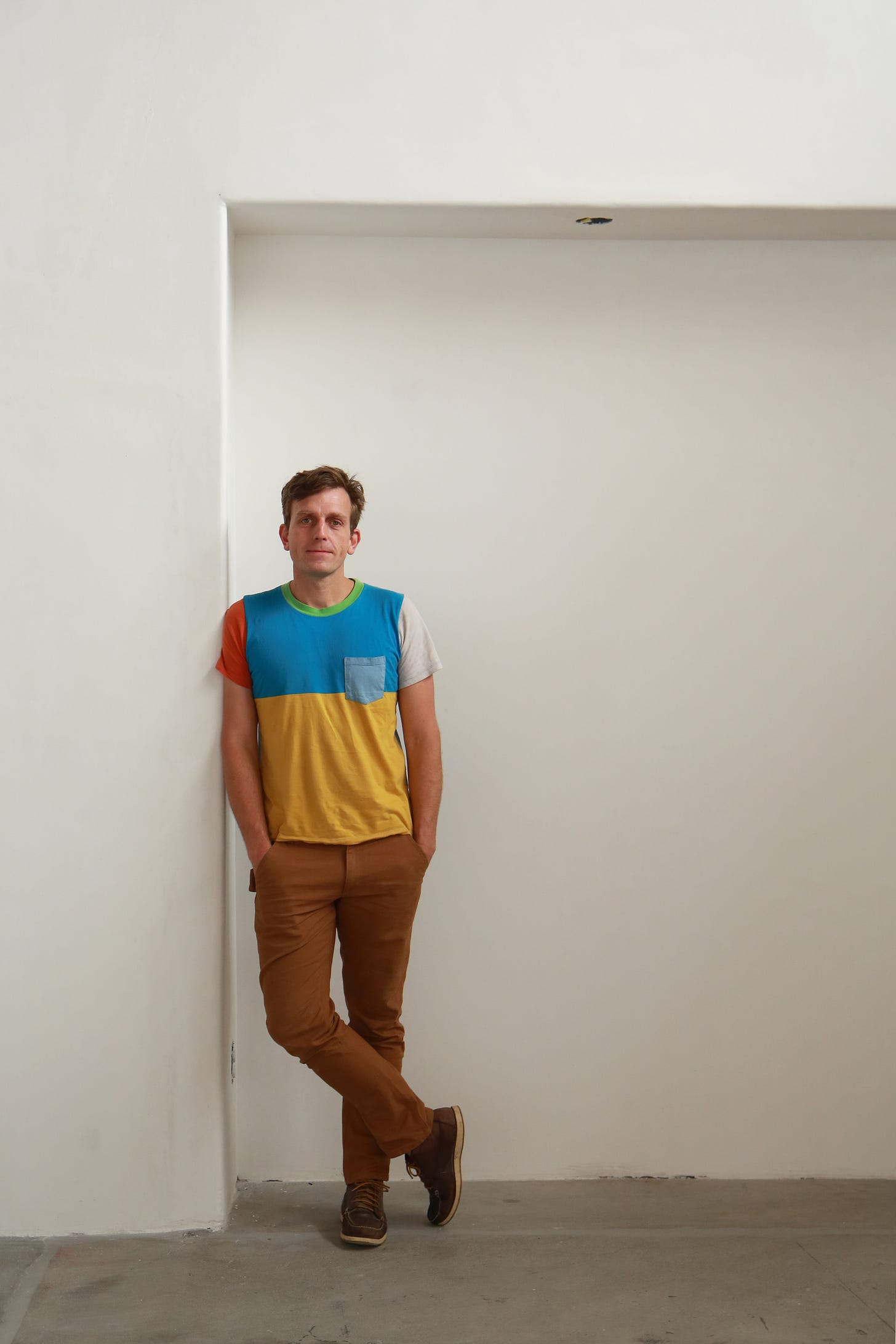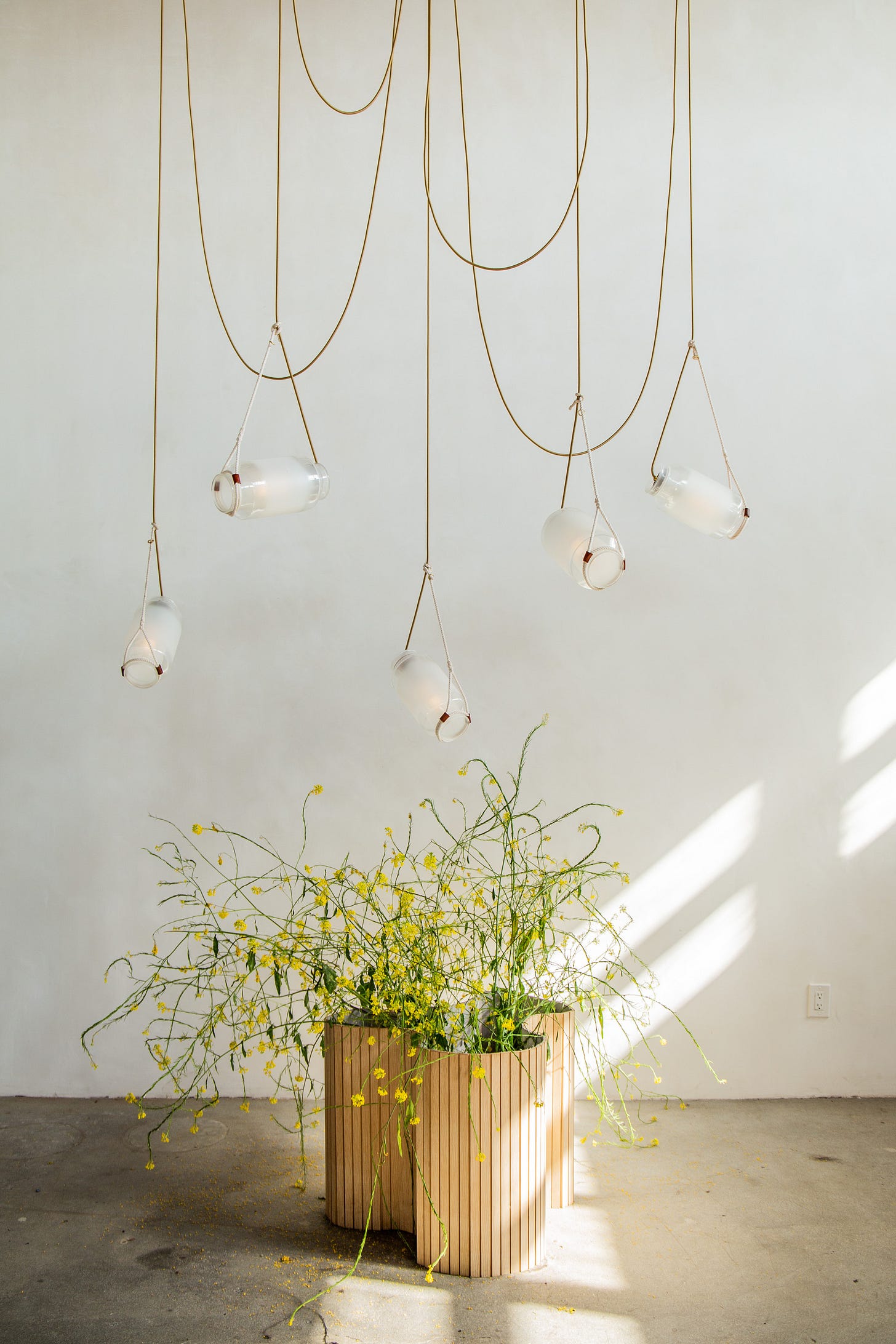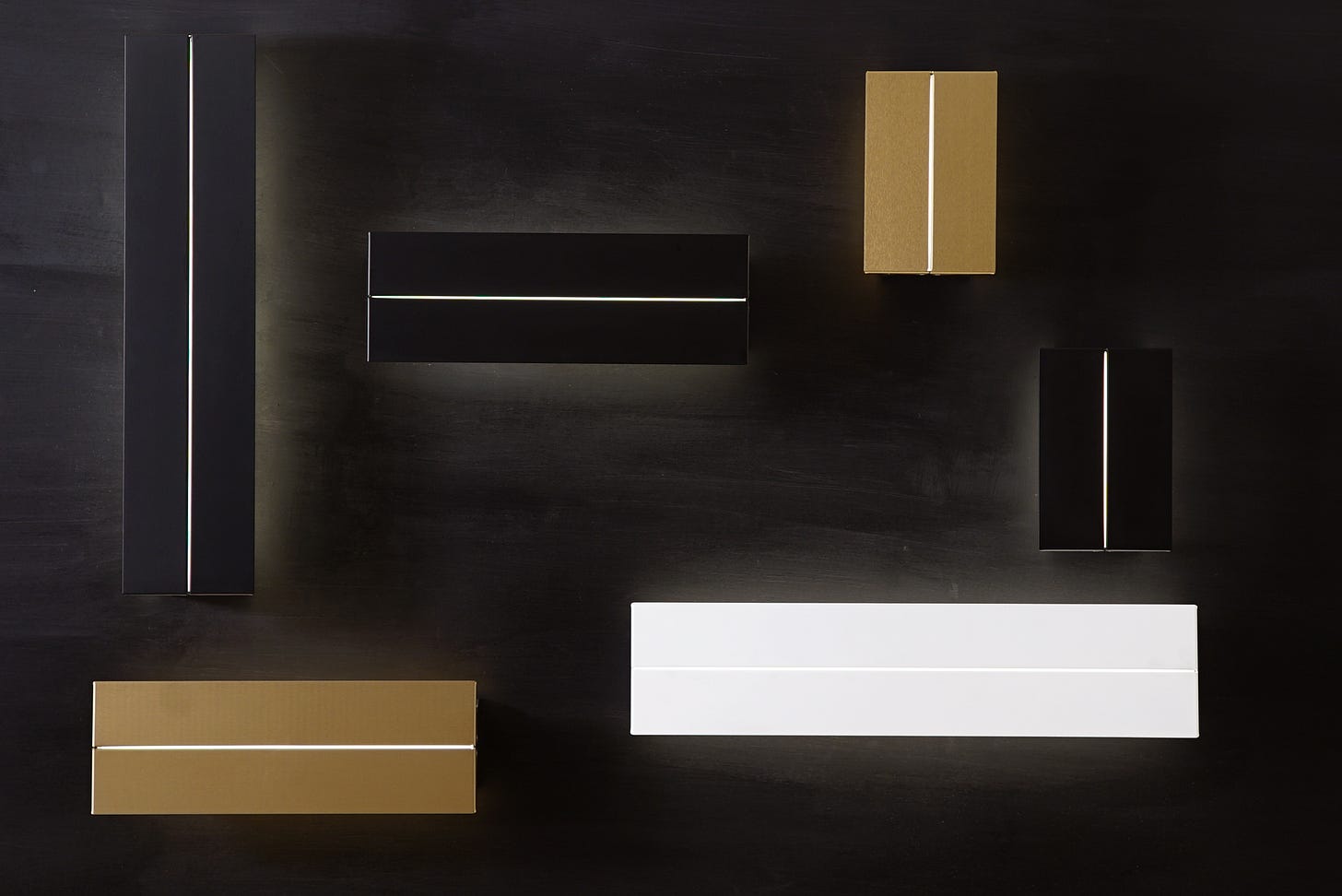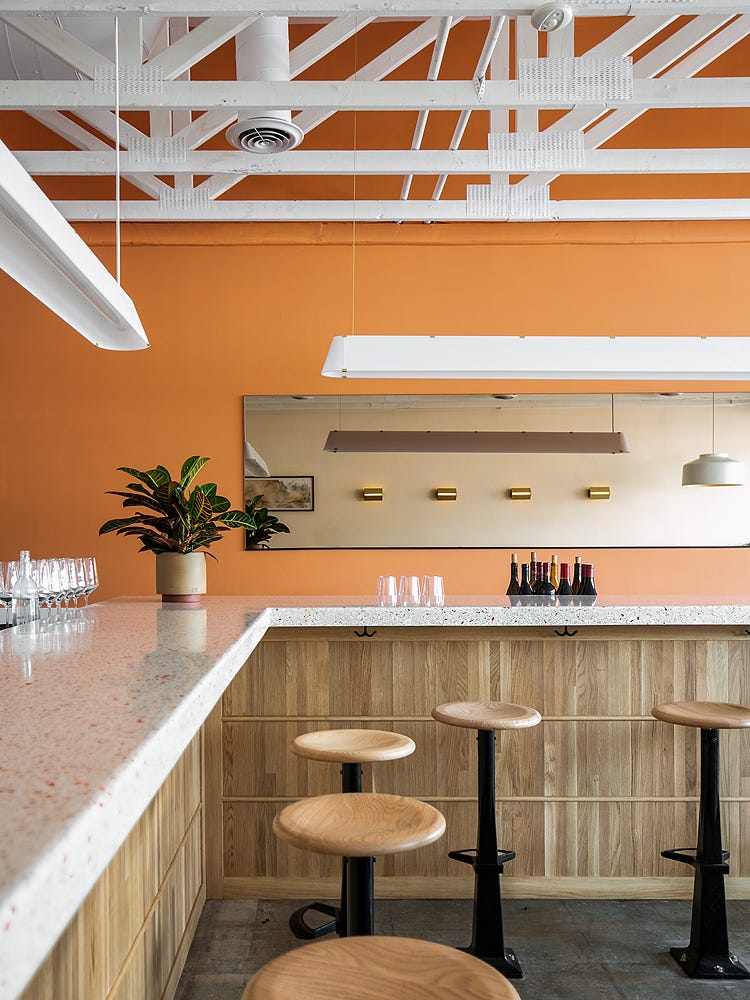In Conversation
Brendan Ravenhill, Ravenhill Studio
When it comes to hospitality, you don’t necessarily think of a lighting studio at the nexus of everything you love about a place. You’re likely to think about your favorite dish, or the playlist first. But mess up the lighting, and the vibe is shot. Screwing in the light bulbs are the last thing to install before welcoming guests in. But it’s also the finishing touch and it quite literally, warms the place. Simple good lighting isn’t the norm; you can instantly clock “cheap” when the overheads are blaring and your face is reflected neon in the mirror. I’m always surprised when a seemingly swanky restaurant has the high beams on in the baño. It’s jolting and draws you right out of their dreamscape that they’ve painstakingly created (crawl back to that booth, negroni cubes melting, and try to shake what you saw looking back at you).
“Too bright” leaves nothing to the imagination and kills all romance.
“Too dark” feels creepy, hard to see what’s on your plate, and like they’re hiding something.
“Just right” is Ravenhill Studio. But really, so much more. Brendan Ravenhill’s lights are beautiful, glowing, romantic, inspiring, creative-juices-flowing, energetic lighting.
In addition, somehow this studio has gone so much bigger than the on-paper job description of Lighting Design. They have enveloped hospitality, drawing inspiration from layers upon layers, inviting artists, chefs, locals and creatives into their studio. The lights flick on, the table fills up with homemade deliciousness, the conversation and wine flows. It has to be this undertone of magic that makes your favorite place feel full of life when the lights go on.
I attended my first dinner at their studio a few years ago. It was around Thanksgiving and the menu was vegetarian - a welcome respite from the over-stuffing that happens around the holidays. An easy and thoughtful detail for those of us who feel over-socialized and overly gluttonous for 2 months straight. No one was subconsciously scrolling or proactively influencing the evening away. Everyone was engaged in conversation and it was fun! Maybe it was because I had just come off of maternity leave and hadn’t been with many adults in awhile, but it felt like the good-old-fashioned, sort-of-spontaneous, dinner party with interesting and creative guests that I had been craving and felt few and far between post-pandemic. And it makes perfect sense that this crew was assembled by Brendan and his wife, Marjory; both of whom are down to earth, kind and welcoming, not to mention incredibly talented people.
It was great to chat with Brendan Ravenhill about his work, his process, favorite spots and inspiration.
In a sentence how do you describe what Ravenhill Studio does (and what you do at Ravenhill)?
We create designs that are a celebration of function, material and craft. I’m the design director and principal of the Studio.
What is the road you took to establish the studio?
We have that classic started-out-of-a-garage story but in our case it was a hallway alcove in a cantilevered apartment on a hill in Echo Park. Today we’re 15 people strong, and growing, and we run our Studio out of a factory space that was once a Capitol Records pressing plant. For the first few years we focused primarily on product licensing and we designed a few local restaurants. The custom products we designed for those spaces took on a life of their own and led us to develop a Studio practice that taps into the Los Angeles manufacturing sector to explore a range of materials and fabrication processes. We’re known for pushing manufacturing methods to create enduring lighting designs.
You create lighting but your brand seems so layered and immersive for the end user. On your website you have city guides for people to see your lighting in the wild, and check out your favorite pitstops along the way. I also loved reading up on your Slide Study where you celebrated the Slide Floor Lamp by building a New York City treasure hunt for curious design lovers to check out visit-worthy slides. This is all somewhat rare for a lighting studio to build so much story around the product for the buyer. I really love it. Tell us more about this approach and the stories that you tell via the brand.
I was giving an architect a studio tour recently, someone who we’ve worked with for years who brought a client over to see the Studio, and I heard him telling his client that she should follow us on Instagram because “it’s not what you’d expect from a lighting brand.” I laughed, I guess that’s right. We’re in it for the stories. We think a lot about the lives that people lead beneath and around the lights we design. We love to imagine their stories, and so on our end, we’re always trying to make things that our customers are inspired to tell the stories behind. Lights are just a part of what we do. We’re mostly trying to have fun and bring beauty to the world, and I think you see that in the way we tell stories about the Studio and what we’re up to. We’re always thinking about what else we can do to delight and surprise the people who are nice enough to be paying attention to us in the first place.
I admittedly know next to nothing about what it takes to create a light. And you make them just right. The absolute perfect, sort of diffused, magical glow. For dummies, how is it done?
That’s so nice! A big part of it is editing. In our discovery we think a lot about the quality of light and how a fixture is going to be experienced. There are plenty of lights we won’t make because we know the quality won’t stand up – you won’t want to eat dinner with your family under that light, or read by that light in your hotel bed. We find success by stripping excess and ornament from our initial ideas until we’re left with what’s beautiful but also truly functional.
Who or what inspires you? Within or outside of the hospitality industry.
Japanese onsen culture and the experience of ritual bathing. Wooden boats and the working waterfront in Maine. I’m always trying to bring these experiences back into our designs. I’m also inspired by the intentional work of activist-artists like Tanya Aguiniga, and by musical experiences like those curated by @Dublab and @Dubfrosty who’s now at The LA Phil.
Where do you get inspiration in the physical sense? IE specific books, museums, instagram handles. Do you have a ritual of collecting inspiration or does it find you?
We track a lot of our inspiration using #inputforoutput on Instagram and Pinterest. Right now I’m spending too much time on OffCenterHarbor.com / @offcenterharbor, which is a treasure trove of boat building videos. @haystackjoinery (Maine) and @dylaniwakuni (Japan) are timber-framers I lose a lot of time with. I’m reading a book about Louis Kahn drawings as a way of understanding his process, though my go-to genre is historical fiction set on small islands, specifically the novels of Ruth Moore. I’m also inspired by the people on our team at the studio – they’re all makers and creatives in their own ways.
Your studio is located in an original Capitol Records printing press. It's an incredible building that you have lovingly restored. Tell us about the space and the restoration process.
Our building has lived many lives, and each part of the space tells a story. The main atrium was built at the turn of the century when the building was a lumber yard and builders still had to bring natural light into a space because fluorescents hadn’t been invented yet. Our office space is a Streamline Moderne addition built when the building was occupied by a diesel engineering school who also installed the Art Deco frieze outside that’s an homage to diesel engines – zeppelins, ships and diesel trains, all hand carved. We use Creative Fridays weekly to improve our space, hand painting checkerboard floors in the lobby, carving a cedar sink by the bathrooms, making custom built furniture. The Studio is a showcase for our lighting but it’s also an ongoing design project of its own.
You host beautiful dinners at your studio and I'm grateful to have been invited to a few. It's always such a lovely crew of creatives and a moment to genuinely connect with people. It's not often that a lighting studio has the ability to build community in this way - you're creating unique hospitality experiences with these dinners. How did this idea come about and what do they mean to you?
We’re always glad to have you. We’re 22 dinners in! Everyone should eat out and support their favorite local restaurants, in Los Angeles this has never been more true. But we started doubling down on community after the pandemic, and this felt like an organic way to bring people together. We have this inspiring space which we’ve built out over the years, and it feels so easy to make nice food with co-hosts, whether that’s @bzippy or @kalon or @earl_home or @fyrn, to spend an evening together eating and talking and chasing rainbows on the roof. ravenhillstudio.com/pages/studio-dinners
I'd also like to know about your floating Sauna in Maine...
The Sea Sauna was a pandemic project, something we took on when the mindfulness of repetitive physical work (cedar shingling) was a welcome release. We put the sauna in the water from June to August on an island where I grew up as a summer kid and worked on lobster boats for a few years after college. It’s a lightly built structure where the exterior shingles are left exposed as the interior walls. Built with mostly gifted and reclaimed materials, it’s heated by a sauna stove that our island neighbor, the jeweler and builder Sam Shaw, welded in the late 1970s, and sits on a fisherman’s float that had been discarded under a bramble of island sea roses. We use an old trailer axle and a buddy’s tractor to pull the Sea Sauna back on land for the winter, and sometimes island friends will use it in the snowy months when we’re home in California.
Ideation : How do you begin a new idea? Tell us about your creative start/kick off process.
We often start with a problem we want to solve, and the kick off is about understanding the question we’re trying to answer or address. That could be an exploration of material properties, or a certain form factor. We talk to interior designers and architects and ask them for holes they see in the market or problems they’d love someone to solve for them. Then we get lost in historical precedent, design references, manufacturing methods, until eventually, hopefully, finding our way back above ground with an original idea in hand.
What is your relationship to feedback? Do you accept feedback easily? How do you decide what to incorporate and what not to?
I want to say I’m very open to feedback and always welcome good constructive criticism, but I’ve also learned over the years that some people’s opinions do matter more to me than others. I like feedback, and if I see how an idea makes my idea better I’ll adopt it gratefully.
Is there a medium that you're interested in exploring that is outside of your day to day role?
I’m always looking to find more time to make wood sculptures. I’d love to do more with casting. Summer in Maine is our outlet for building and working in new ways that ultimately inform what we produce as a studio. We build small island structures, maintain and repair waterfront properties, including a building we steward on behalf of the National Park Service, and with @islesfordboatworks we build a wooden boat every summer (or half a boat, really, since every summer we build the second half of last year’s boat and the first half of next year’s boat).
Favorite hospitality space you've visited recently and why? (hotel, restaurant, bodega...)
Huerto, the back garden of Criollo, a very well regarded restaurant in Oaxaca. Huerto means ‘vegetable patch’ and it’s where the restaurant serves a very low key and very delicious weekend brunch of mostly wood-fired dishes. Their outdoor kitchens really make you see the connection between food and well being, they look and feel like apothecaries.
Also @comalrestaurante in Ensenada, part of the Plaza Santo Tomás, an old bottling plant complex that now has so much to offer – Tanto Santo for pizza, Hogaza Hogaza for bread, La Bête Noire for records and cocktails, Limón Limón for ice cream. Comal is a newer addition emphasizing traditional Oaxacan ingredients and the social importance of corn. They bought a mill and do the grinding and nixtamalization processes there. I think they’re connected actually – the self-taught chef at Comal used to work at Criollo once upon a time.
Favorite hotel that you'd like to return to again and again? What about it is so perfect for you?
One day I’ll spend more time in hotels. I don’t get the chance to go to many, but Airbnb may be forcing all of our hands, I think for the better. Hotels have never seemed so affordable. We tend to seek out comfort that doesn’t take itself too seriously. We’ve been going to Cuatros Cuatros in the Valle de Guadalupe since 2012 or so, and of all the places you can glamp, there’s something about the orientation of their Montana canvas tents on the property and the way they designed their indoor/outdoor showers that really works for me.
We also recently went to Huttopia in Paradise Springs, an hour from Los Angeles, and can’t wait to go back. It’s run by a French couple and set in a mountain canyon that used to be a Hollywood getaway for Charlie Chaplin’s generation. There’s an old Hollywood charm (the stocked fishing pond gone feral, a giant pool the likes of which you’d never build today), and a pleasing balance between rustic and comfort. With young kids in tow, at this point in our lives it’s all about the amenities – someone to make you crepes and fresh squeezed orange juice, wood fired pizza, s’mores, an outdoor movie.
3 hospitality spaces where you love the application of Ravenhill lighting. We'll all go check 'em out in person.
Our Plug-In Cord Sconces at Radio Hotel by Sloane Company
Radio Hotel (scroll down)- https://www.timeout.com/newyork/hotels/best-family-hotels-in-nyc
Kelly Wearstler’s design of the Peacock (restaurant) at the Austin Proper, using individual Float Pendants to accent the space.
I’ve also always loved the Opal Beam Pendants over the bar at Agnes in Pasadena, designed by ora.la
Anything else you'd like to share? Thank you for participating!
There’s no better time for people to support L.A. businesses – especially interior designers and architects, many of whom lost major projects in the fires along with their personal homes. The rebuild process is going to take a long time, and in these in-between months when everyone’s still reeling from the devastation and piecing their lives back together and haggling with insurers, a lot of our clients who are interior designers and architects are finding themselves at a standstill. If you are looking for good people to work with, look to L.A.!









I'm inspired to create. Thanks for bringing this to your readers. Great questions and I love his sensibility.
Always so interesting to learn more about what other people are curious about and how it inspires their creativity - thanks for sharing this convo with Brendan!!